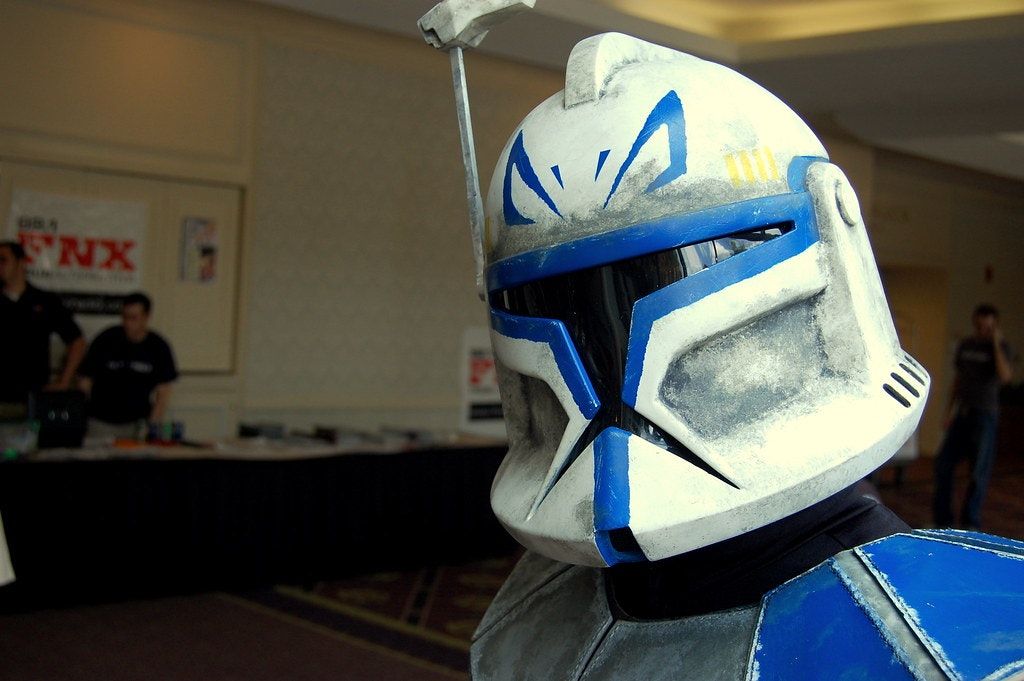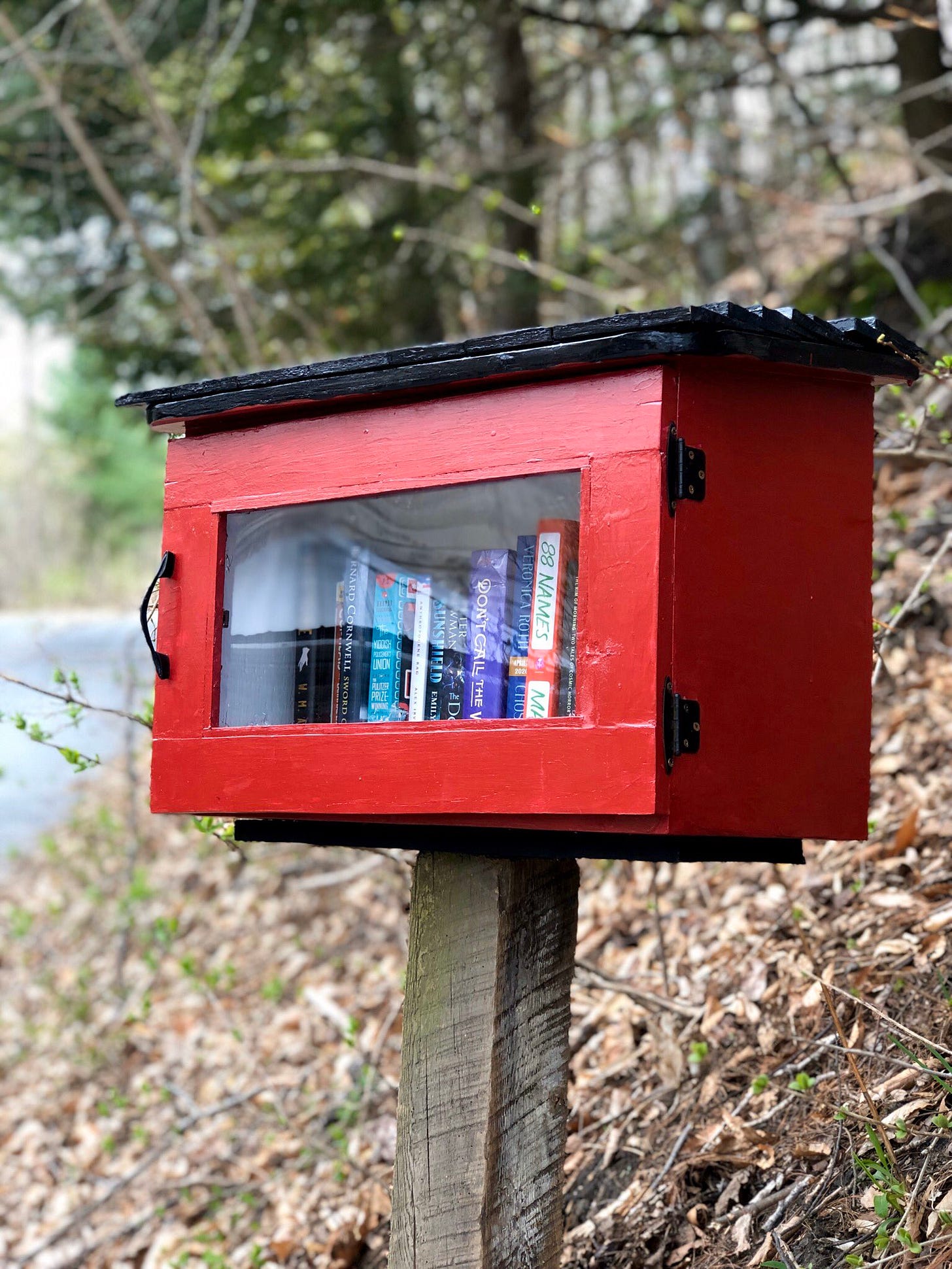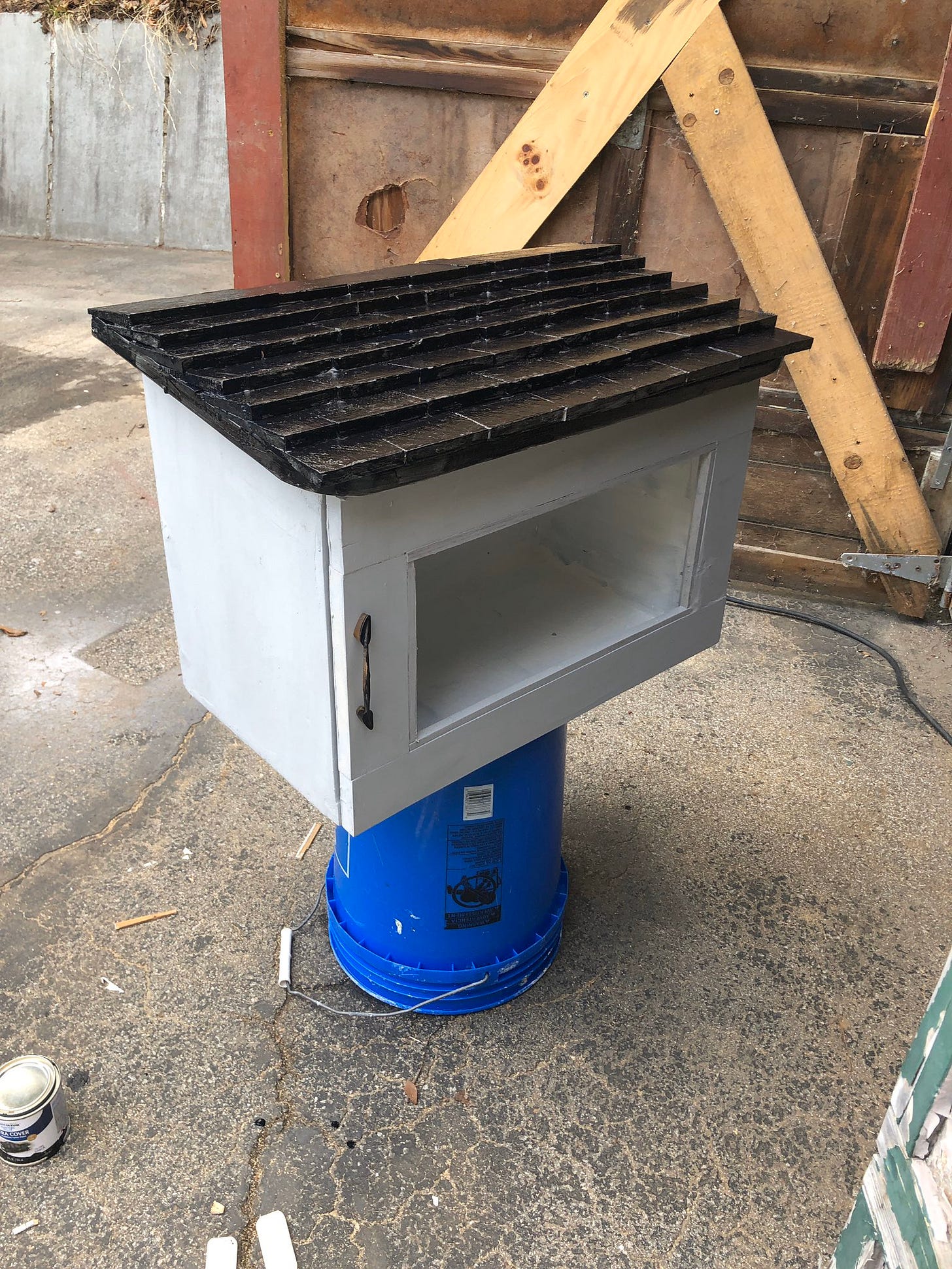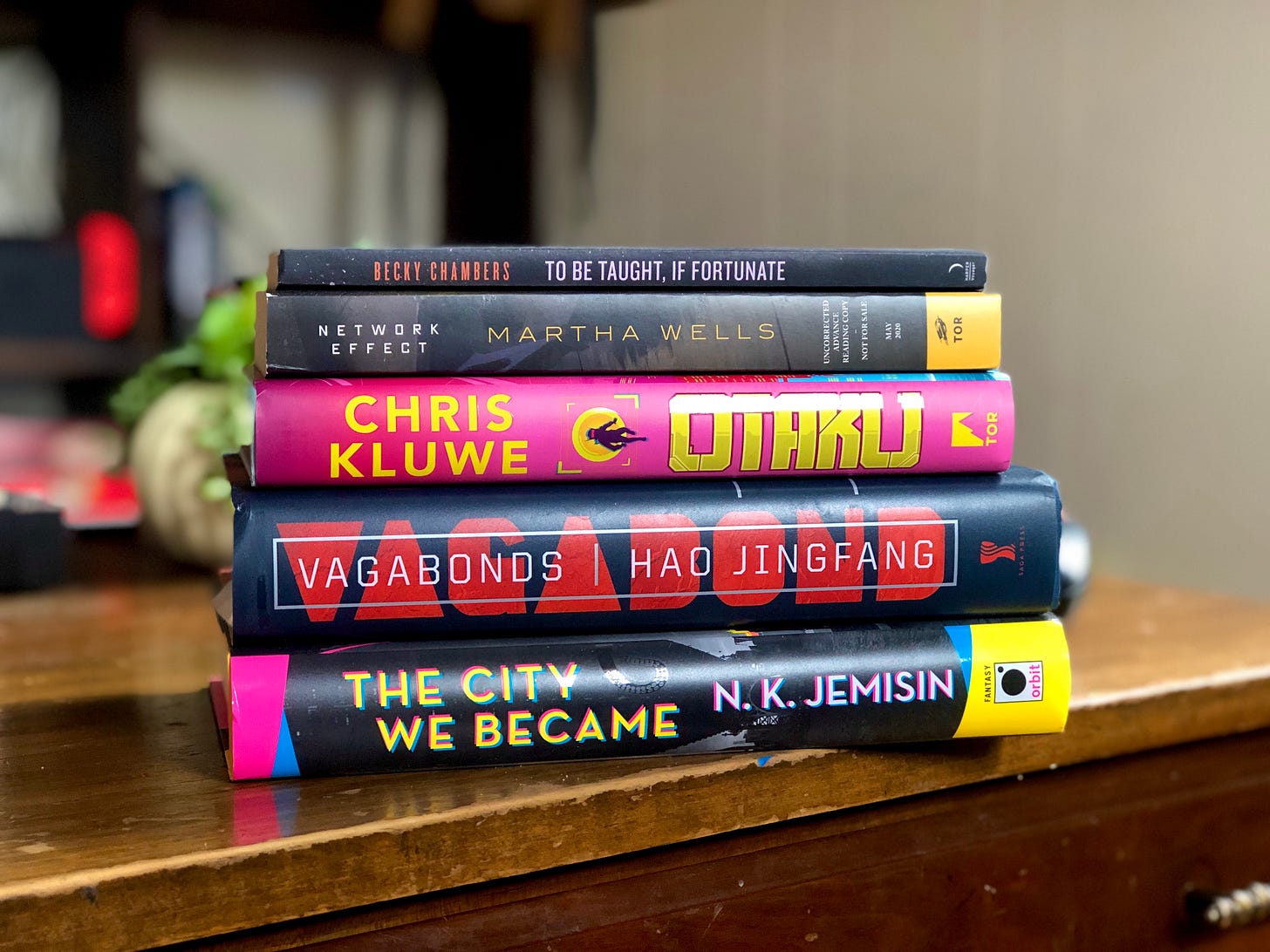The End of the War

Greetings!
I hope that you’re doing well. I’ve got a lot coming up in this newsletter. First up, some potential changes to this letter that I’d love to get your thoughts on. After that, thoughts on the end of The Clone Wars, Eddie Robson’s Hearts of Oak, building a Little Free Library, and more.
Housekeeping
I’m pondering a couple of changes to this newsletter, and I’d love to get your input.
The state of the media world is … not great right now, and as a freelance writer, there are some increasingly worrisome signs on the horizon. Several publications that I write for are starting to pull back their freelance budgets; editors aren’t getting back to me on pitches, I’m seeing more pitches turned down than usual, and some have shut down altogether.
Given that we’re likely headed into a bad recession, I can’t imagine that things will get easier for freelancers, given that budgets will be tighter as advertising revenue dries up, more writers will likely get laid off and as outlets rely more on in-house staff for content. This is not great if you’re relying on freelance for your income.
Substack has the option to offer paid subscriptions to readers, and that’s something that I’m contemplating. Upfront: if I do go forward with it, I will continue to offer up a free tier to everyone: that’s not going anywhere. This newsletter is a lot of fun to write, and I want to make sure people keep enjoying it.
But, this does take time to put together, and I’m thinking that a paid tier might be a good opportunity to write out some longer-form stuff: bigger essays / interviews / profiles / original fiction, etc. I have some ambitious projects that I’m plotting out (in-depth series on the history of Dune, anyone?)
Cost-wise, Substack recommends a $5 a month / $50 a year price point. There’s also an option for people to sign up as a “founding member”, which allows you to pay a custom amount above that regular plan. Things like regular reviews and commentary, and sections like Currently Reading / Further Reading / book reviews would remain free for all subscribers.
The upside is that I’d be able to justify more time to this and put it onto a bit of a more regular schedule, and it could help relieve some worries about income in the months ahead. Who knows? Maybe this can be built out further, with other contributors and more short fiction or something.
Please let me know what you think, either way. What would make a paid plan worthwhile for you? Let me know what you’d like to see more of. Less of?
In the meantime, I have two changes in the short-term that I’m instituting:
- Standalone issues with an interview from an SF/F creator about their book or project. (I’ve got some good ones lined up!) Stay tuned for those.
- Affiliate links via Bookshop.org. Basically, anytime I mention a book, I’ll provide a link that’ll go to the retailer. This won’t impact the editorial side of things: I’m not going to change the types of books that I recommend or what I’m saying about them. Nor does it mean that I will be less inclined to call out Bookshop.org if they mess something up. But do understand that clicking on a link might mean I get a percentage of any sales that result. Bookshop also allows me to essentially set up my own, personal storefront, and I’ll be putting together lists of books that I’m reading over there.
Okay, onto the regularly-scheduled #content you’ve signed up for.
The End of the War
Almost 20 years ago, a couple of Star Wars fans invited me to write up a couple of reviews of some recently-released comics and novels, all part of a larger Clone Wars story project. The website was called The Unofficial Clone Wars Site, and was run by a couple of fellow fans: Paul Meyers and Brian Gates. Together with another fan, Nathan O’Keefe, we set out to chart out the growing, complicated story between Attack of the Clones and Revenge of the Sith.
There was a lot for us to cover: short stories, comic books, novels, a series of weekly webcomics, and an animated series from Genndy Tartakovsky. Our goal was to make sense of the chronology, as well as cover the latest developments. We published a ton of reviews, summaries of each of the battles, and interviews with many of the creators — some of whom I’m still in touch with.
In October 2008, I was sitting in the new student lounge at Norwich University with my friends Stuart and Mike, as well as other members of the school’s gaming club. We reserved the room to watch the premiere of the new series The Clone Wars on Cartoon Network. It kicked off with the episode “Ambush,” an episode about Yoda leading a handful of Clone Troopers through a sea of Battle Droids. Months earlier, I’d trooped at the premiere of the animated film in Williston with a 501st recruit. Both times, we all came away unimpressed. The animation was strange. The characters were whiney and annoying. The battle droids were even worse than they were in the prequel films. I stuck with the TV series for random episodes, but didn’t follow it exhaustively.
But the TV series did something interesting: it put the 501st Legion into overdrive. Everyone went crazy for clone troopers. A fellow garrison member went out and built his own molds to make his own armor, and they turned out dozens of suits in short order. I put together a clone trooper of my own, a movie-accurate grunt from Attack of the Clones. I made another one from the TV series, Waxer, for Megan.

Earlier this week, I sat at my kitchen table and cried as Ahsoka Tano and Rex watched as their former friends and brothers tried to kill them, the fallout of Palpatine’s order to eliminate the Jedi — Order 66.
The final handful of episodes have had me riveted to my television. I spent this past couple of months catching up on The Clone Wars. As I rewatched, I realized how much the series improved as time went on, but more importantly, how much the characters grew. The series added so much to the prequels. The animation team and writers got more ambitious when it came to the story and characters. Looking at the entire thing as a whole, cohesive unit, you see what the prequel films really don’t accomplish: a meaningful connection to the characters and the situation they find themselves in.
I’ve written before about one of the show’s strongest points: it humanized the Clones, giving them incredible depth and nuance for their own arc. As I watched the final four episodes, I had this growing sense of dread, because I knew what was coming, and how much that fall would hurt, given how close I’ve gotten to the characters.
I didn’t quite realized the full nature of the way the series impacted the 501st Legion until last year, when I went out to Star Wars Celebration in April and the premiere of Rise of Skywalker in December. I met and befriended a number of fellow clones, whom I’ve chatted with about the ins and outs of not only our costumes, but about the stories that have essentially brought us together. There’s a real sense of camaraderie between troopers, not just because we like the designs of the various units, but because of how the bigger story has effected us.
TUCWS dried up years ago — you can still find a handful of snapshots on the Wayback Machine — not only because we all sort of drifted away from it, but because Lucasfilm eventually launched The Clone Wars in 2008. That series sat uneasily alongside the vast body of work that had already been produced and eventually overwrote it, nullifying our work, but giving us a pile of new stories and work that were just weren’t prepared to deal with. If we were smart, we would have kept the site going — I have no doubt that it could have been a project that would have stood out and been a major part of Star War fandom, but we built up a neat community at a time when the Clone Wars was still real uncharted territory for the franchise.
I miss the site. It’s essentially where I got my start as an online writer. Paul tragically died a number of years ago, and Brian moved on to other things. Nathan and I still chat every now and then.
At the end of the run, what the Clone Wars — the show and the era — demonstrated was that the franchise could operate with long-form storytelling that played out over years, and that while the Skywalker part of the saga was a big part, it wasn’t necessarily an essential one. You could tell an entire spectrum of stories, from deeply philosophical ones about the nature of the Force and good and evil, wartime stories about the morality of the clones, adventure stories, and so on and so forth. It was a grand experiment with some outstanding stories — some of the best that the franchise has generated — and one that I think will remain influential for years to come.
But more than that, the era of the Clone Wars was this big piece of connective tissue for an entire generation of Star Wars fans. Sure, you have the fans who saw A New Hope a dozen times in theaters, then the people who caught the special editions (my specific subset insertion into fandom), the prequel trilogy, and then the Clone Wars. This era brought together a group of fans across message boards over our shared love of comics and short stories, people who loved the idea of brand-new characters sharing screen time with Anakin and Obi-Wan, and costumers who desperately wanted to replicate that Clone Trooper who popped up for just a couple of episodes. The Clone Wars facilitated this vast community of fans, bringing them together across this shared love of character design and story. That’s a rare thing, and I hope that we’ll see it again.
Heart of Oak by Eddie Robson

Eddie Robson’s Heart of Oak was a book that really jumped out at me when I first saw it: it has this fantastic, evocative cover and mysterious premise. The book is an interesting read, one that looks as as though it blends genres, but turns into a straight-up science fiction novel.
The book is a hard one to describe without spoiling the central premise, which I think makes for a more satisfying read. It starts off in a mysterious city, about a woman named Iona, its central architect. The city is made of wood, and for as long as she — and everyone else — can a remember, has been working on it, improving buildings, tearing them down, and rebuilding them into something grander and more ambitious.
Meanwhile, the city’s King is feeling restless and without direction: he openly questions what his role is, and how disconnected he feels from his subjects. When a mysterious woman arrives, she throws things into disarray.
Spoilers ahead.
Robson plays out this story in a surreal fashion: the city and its inhabitants are strange: Iona and others have strange half-memories of words and concepts that they've long forgotten, and when this new visitor arrives, they learn the true nature of their city: they were once colonists bound for a new planet, and crashed after traversing a wormhole. They had picked up some sort of alien life form, and were contained by another alien civilization on the surface of the planet, which has its own objectives.
Robson does a good job here playing out the mystery and surreal nature of this world, and it’s worth reading for the interesting world building (wood is a central element here) and central mystery.
This story felt like it’s something that would have made for an interesting serial in a magazine like Asimov’s or Clarkesworld: the plot could fit nicely into a couple of installments, and teases a really intriguing universe.
What really makes this book stand out is a strength and a weakness. It’s an intriguing story, one that genuinely surprised me: there are weird, unexplained sciences and technologies, wooden robots, memory problems and unreliable narrators, all of which fueled a central mystery that kept the plot going. But that central mystery is why I really don’t feel like rewatching LOST: the journey is in the telling, and not necessarily for what you get out of it.
There’s plenty of mystery left over: I want more from this particular story world: Robson teases some pretty interesting galactic conflicts and future human civilizations, which would make for some cool further adventures if he ends up exploring beyond this one volume.
Little Free Library: Open For Business!

While I've been in lockdown, I've been working on a bunch of projects, and I figured it was time to do something that I've wanted to do for a while: make a Little Free Library.
If you've never heard of Little Free Libraries, they're a worldwide community project that was started in 2009 designed to promote literacy. Essentially, they’re little enclosed bookshelves designed to look like little houses or buildings, from which people can borrow books from.
I inherited a large pile of scrap wood when I bought the house, which was perfect for this. I used a hardcover book as a guide for the height, and cut down the pieces for the three walls and floor. I gave each piece of plywood got a good sanding once I cut them down to shape.

From there, I screwed them together, and I used a repurposed shelf for a roof. I then painted on a couple of layers of primer, which hopefully helped seal some of the old screw holes and seams.
I wanted to give it some character, so I decided to make some shingles for the roof. The house’s prior owner left a ton of old clapboards, so I cut those down into three-inch chunks. With a little trial and error, I figured out how to place them, then glued each shingle in place, and locked it down with a heavy-duty staple. After that, I primed them and then painted them with black exterior paint, which will hopefully protect them from the weather.
After that, I went to work on the front frame and door. I cut down a scrap pine board to frame out the front, and then used the rest for the door. To hold in the glass, I cut down piece of wood to a small strip, then nailed that into place, which allowed me to glue a piece of plexiglass in. That got a coat of primer and paint, and after disassembling a cabinet in my workshop, I got some hinges, a latch, and a handle.

I painted the interior white from paint that I already had on hand, then painted the exterior a nice, bright red with exterior latex paint. Once I glued in the plexiglass, I set up a post next to my driveway, screwed on a base, leveled it, then screwed the box to that. The only thing that I need to do next is add on some sort of seal around the door, which has a couple of gaps around it. I think it’ll be okay, but if it turns out to be a problem, it shouldn’t be an issue to fix. I’m contemplating getting a sign made up for the side that explains what it does. Once my official Little Free Library sign comes in, I’ll add it to the global map.
The entire thing came out pretty well: there are a couple of crooked angles (my table saw doesn’t have a guide, so I think some of my angles on the door aren’t *quite* right, but it gives it a little quirky character.
Now, it’s open for business! It'll likely be science fiction / fantasy-heavy, although I'll try and keep a good variety in there. A lot of kids walk up and down the road to school, so whenever those open again, I’ll try and keep it stocked with some MG/YA-ish stuff. I’ve also got some plans to add in some more local authors. For now, it’s just a variety of books that I pulled off my ARC / Review shelf.
Currently, it's stocked with the following:
- Westside by W.M. Akers
- Cuphead in Carnival Chaos by Ron Bates
- Stealing Thunder by Alina Boyden
- Sword of Kings by Bernard Cornwell
- Anthropocene Rag by Alex Irvine
- Eden by Tim Lebbon
- Sunshield by Emily B. Martin
- The Deathless by Peter Newman
- Creeping Jenny by Jeff Noon
- Don't Call the Wolf by Aleksandra Ross
- Chosen Ones by Veronica Roth
- 88 Names by Matt Ruff
- The Rim of Morning: Two Tales of Cosmic Horror by William Sloane
- Blackout by Connie Willis
- The Glass Magician by Caroline Stevermer
- The Sisters Grimm by Menna van Pragg
- The Iron Will of Genie Lo by F.C. Yee.
There are also a couple of recent issues of Wired and National Geographic Magazines.
The box also comes with a small notepad and a stamper for people to put down their name / date / book when they borrow something — that's optional, but it'll give me an idea of how many people are borrowing things.
Since I’ve set it up, I’ve already had one person stop by and take two books! Someone also stole the pen that I had in there. I posted about its installation on my local Front Porch Forum, which generated a couple of responses, including one from our mayor, which was pretty neat. I’m also setting up a Twitter feed for the library, but inadvertently got locked out of it. Hopefully that’ll be resolved soon, but keep an eye out for it at @MillSt_LFL.
Hopefully, it'll provide people with a good read while we're all stuck at home.
Currently Reading

I picked up and finished Heart of Oak since I sent out my last newsletter, and I’m still working on Vagabonds and The City We Became. Vagabonds is going along more quickly, because I’ve also got the audio version of that (thanks to Libro.fm, which provided it as part of their reviewer program). I’ve been bouncing between the two, listening to longer sections while driving or walking, and reading chapters when I get home. I’m almost done with it: just a 150 or so pages to go, and then I’ll likely shift over to The City We Became.
I’m also reading E.K. Johnson’s Ahsoka, which is a good followup to The Clone Wars ending. It’s interesting: this book was written after the series was canceled, and there’s some crossover between it and the final episodes. It’ll be interesting to see how it turns out.
Up next, I’ve got Network Effect by Martha Wells, and am eyeing Shorefall by Robert Jackson Bennett, as well as To Be Taught if Fortunate, Becky Chambers, Liquid Crystal Nightingale by Eeleen Lee, and Otaku by Chris Kluwe (which I’ve started, but need to get back to.)
Further Reading
- Book buying habits. Angela Lashbrook of OneZero has a neat piece up about a pair of bookstore platforms, Bookshop.org and Libro.fm, which have been doing really well while we’re all locked down, and how they might cope post-pandemic.
- Coronavirus and Imagination. Kim Stanley Robinson has been on a roll recently. He has a new essay up in The New Yorker about how the Coronavirus is changing our imaginations.
- Jojo Lothcat. Taika Waititi is writing and directing a Star Wars movie. This is not a drill. His film Jojo Rabbit is fantastic, and you should watch it.
- Making Ahsoka. I’ve got a big piece up on Cosplay Central about Wretched Hive Creations, and how its owner, Bob Gouveia makes some fantastic Ahsoka Tano headdresses.
- Race and publishing. The Guardian’s Alison Flood profiled N.K. Jemisin about her new book and career. It’s a really good look at how she’s risen to such prominence, and the challenges that she’s faced.
- The Rise and Fall of Joshua Trank. Matt Patches over on Polygon has a phenomenal piece up about director Joshua Trank, who rose to prominence with his film Chronicle, then seemingly melted down around his film Fantastic Four. Go read it.
- Stalkers. The area around the Chernobyl nuclear plant is burning, and authorities are placing the blame on a group of explorers who apparently revere Soviet-era SF authors Arkady and Boris Strugatsky, particularly their book Roadside Picnic. Just in case you didn’t think real life was weird enough.
- We need better LOTR games. Aidan Moher has a piece up on Medium about how he’s really irritated that video game adaptations of J.R.R. Tolkien’s works are always super dark and grim. I’ve long wanted someone to adapt Lord of the Rings in the exact style of Breath of the Wild, where you complete the quest to destroy the Ring of Power, get into random fights with Orcs and goblins, but also do a bunch of side quests or collect food and whatnot from the countryside.
- What’s in my bag? I’ve got an entry coming up (Wednesday the 13th, I think?) in this neat newsletter I came across recently. You can sign up for that here.
That’s it for now. As always, thank you for reading. Let me know what you think (email me or leave a comment!), and if you liked this, feel free to pass it along to someone you think would also enjoy it.
Next newsletter, expect an interview with The Last Emperox’s John Scalzi, about collapsing civilizations and pandemics.
Andrew